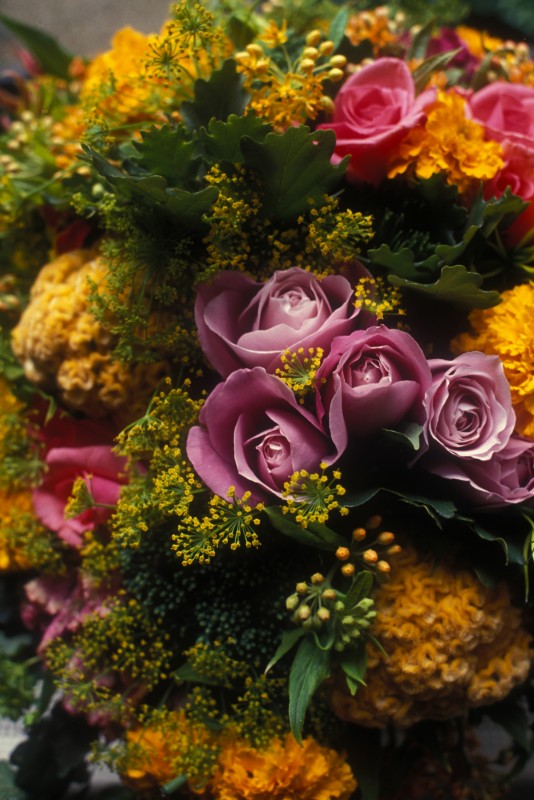Say It With Flowers

“Comme c’est bizarre,” says Colombine, “every year for la fête des mères (Mother’s Day; in France it’s the last Sunday in May) ma belle-mère (my mother-in law) gives me a cactus!”
“C’est peut-être symbolique,” I answer. The arid cactus, with its prickly defense system, makes me craindre le pire (fear the worst). Symbols can be thorny subjects. We peruse the 1882 dictionary Le Langage des Fleurs and discover “cactus: symbolise l’amour maternel.” Colombine looks relieved. “Dites-le avec des fleurs!” (Say it with flowers.)
I bought the book after the first time Colombine invited me for dinner. It was late October, and I, a clueless and impoverished foreign student, arrived with a huge bouquet of chrysanthèmes jaunes. Her face fell. Oups! What have I done now? “Oh là là!“ she said, “tu commémores ma mort?” Quoi? I’m commemorating her death? Blessedly inexpensive, in the fleuriste‘s window at twilight, the mums had seemed luminous. But for Colombine, my gift had an unfortunate connotation funéraire. How could I guess the chrysanthemum symbolizes le souvenir des défunts (remembering the deceased)? On la Toussaint (All Saint’s Day, Nov 1) you put them on tombstones. Luckily Colombine and I are still friends.
Since in France your flowers send a message, you need to know what you’re saying. And you’d better hope whoever receives them uses the same dictionary, because there isn’t much agreement on the symbolic definitions.
Let’s take a hypothetical bouquet. Wandering through the garden, you start with marguerites (daisies). They mean innocence, grandeur, fidélité, estime and “je t’aime.” Add some oeillets (carnations) to signal amour sincère, ardeur, finesse, affection. Now pick a pivoine (peony) to promise sincérité, régénération, transformation spirituelle, abondance and pouvoir protecteur (protective powers). On your way past the pond, a nymphéa or nénuphar (water lily) catches your eye. Good choice! They not only suggest your qualities: intuition, créativité, pureté du coeur, éloquence and amitié, they promise surprises, heureux bouleversement (head-over-heels happiness) and, ambiguously, to unleash les passions les plus déraisonnables (the most unreasonable passions) while inciting your beloved to s’élever au-dessus des voluptés sensuelles (rise above sensual pleasures). Not to mention that nénuphars are the preferred homes of naïades (water fairies). On the way home, add a few boutons d’or (buttercups, ranunculus) for la joie.
But what if your beloved has read a different dico (dictionary)? Here’s the same bouquet, version fleurs du mal. It isn’t exactly conter fleurette (sweet talking). By this book, marguerite means adieu, and oeillet porte malheur (brings bad luck): jalousie, exigence, caprice, dédain (disdain), refus, oubli du coeur (lost love). It says “Vous avez une rivale.” La pivoine signifies amour inassouvi (unfulfilled love), and the nénuphar represents froideur (cold-heartedness) and désespoir (despair). No wonder in Boris Vian’s novel L’Écume des Jours (1963), the heroine’s surrealistic “nénuphar dans le poumon (lung)” is fatal. Beware the buttercups as well. It turns out they’re potentially poisonous, full of reproches and impatience. They say “danger, vous êtes ingrate (graceless and/or ungrateful), vous méconnaissez (misunderstand and/or underestimate) mon amour.” By the way, renoncule, literally translated, means “grenouille en colère” (angry frog). Which is what your French friend may be, after analyzing your flowers.
Linguistic traps lie everywhere. Even the lowly pissenlit (literally “bed-wetter”: dandelion), which according to your dico des fleurs means “je répands la bonne semence” (I spread good seed) is often used in the expression “manger les pissenlits par la racine” (“eating dandelions from the roots up,” equivalent to “pushing up daisies,” i.e., dead). And does Colombine mean columbine? Nope. That’s ancolie (symbolically, “madness”). Colombine, in Italian Commedia dell’Arte, is Pierrot’s beloved. But in French, I was horrified to discover, colombine means fiente de colombe (pigeon droppings)! Fertilizer, quoi.
Share to: Facebook Twitter LinkedIn Email
Leave a reply
Your email address will not be published. Required fields are marked *




REPLY